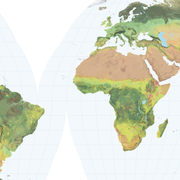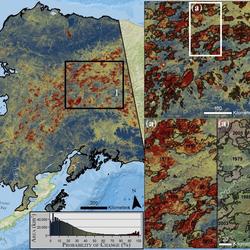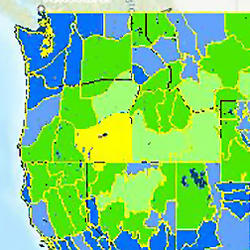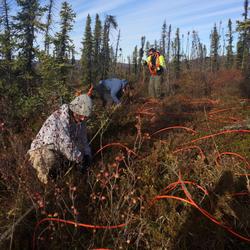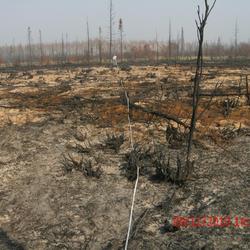Due to a lapse in appropriations, the majority of USGS websites may not be up to date and may not reflect current conditions. Websites displaying real-time data, such as Earthquake and Water and information needed for public health and safety will be updated with limited support. Additionally, USGS will not be able to respond to inquiries until appropriations are enacted. For more information, please see www.doi.gov/shutdown
Land Change Science Program
Home
Programs L2 Landing Page
Changes in the environment, land use, and climate can have significant impacts on our Nation’s economy, natural resources, infrastructure, and water, food, and energy security. To strengthen our Nation’s ability to respond and adapt to these stressors, the USGS Land Change Science Program conducts research to improve understanding of rates, causes, and consequences of climate and land use change.
Land Change Science studies the spatial patterns, processes and consequences of changes in climate, land use and land cover and contributes the fundamental science basis needed to develop sustainable resource management strategies.
Land-Sea Linkages in the Arctic
The Arctic is undergoing historically unprecedented changes in weather, sea ice, temperature and ecosystems. These changes have led to greater coastal erosion, greater export of freshwater, and changes to marine and terrestrial ecosystems, habitats, and productivity, among other trends. Meanwhile, many believe the Arctic “amplifies” large climate changes during both warm periods and ice ages...
Global Hyperspectral Imaging Spectroscopy of Agricultural-Crops & Vegetation (GHISA)
This webpage showcases the key research advances made in hyperspectral remote sensing of agricultural crops and vegetation over the last 50 years. There are three focus areas:
Fire Danger Forecast
USGS Earth Resources Observation and Science (EROS), in conjunction with the US Forest Service Pacific Southwest (PSW) Region, has developed several new products for understanding and forecasting the probability of large wildland fires on all land in the conterminous U.S.
Ecosystem Services Assessment and Valuation
Ecosystem services are the benefits that nature provides to human well-being: clean air and water, protection from natural disasters, fisheries, crop pollination and control of pests and disease, and outdoor places for recreation, solitude, and renewal. Ecosystem services underlie the functioning of our entire economy. They are neither worthless nor priceless, and by integrating the physical...
Effects of Energy Development Strategies
Energy is a cornerstone issue for humanity, nations, and individuals. How we create and use energy impacts the consequences it embodies. The critical issue facing humanity involves meeting our massive and growing energy needs, without undermining human and natural capital. Facing the challenge of long-term, sustainable energy for the nation and world requires understanding the consequences of...
Geologic Records of High Sea Levels
This project studies past high sea levels on coastlines that preserve fossil coral reefs or marine terraces. We ascertain the magnitudes of sea-level high stands by field mapping, stratigraphic measurements, and precise elevation measurements. Geochronology is accomplished by radiocarbon dating of mollusks (for Holocene-to-last-glacial deposits), uranium-series dating of corals (for high-sea...
Global Ecosystems
The Earth contains an astonishing variety of terrestrial, freshwater, and marine ecosystems, which provide biological resources and services that are essential to our survival. A high resolution, data-derived, global ecosystems map will improve our ability to manage, conserve, and restore ecosystems that are increasingly threatened by fragmentation, alteration, loss, invasive species, fire,...
Paleohydrology of Desert Wetlands
Springs and wetlands are among the most highly threatened ecosystems on Earth. Although geographically limited, they support more than 20% of all the threatened and endangered species in the United States. Scientists from the U.S. Geological Survey are examining the rock record to determine how springs and wetlands responded to abrupt climate change during prehistoric times and the recent...
Terrestrial Records of Holocene Climate Change: Fire, climate and humans
Large wildfires have raged across the western Americas in the past decade including the Las Conchas, New Mexico fire that burned 44,000 acres in a single day in 2011 (Orem and Pelletier, 2015, Geomorphology 232: 224-238, and references therein), the 2016 Fort McMurray, Alberta fire that required evacuating an entire city, and the...
Assessing Societal Vulnerability to Natural Hazards
Risk and vulnerability studies that seek to improve the scientific basis for assessments and develop quantitative, qualitative, geospatial decision support tools that characterize and communicate the vulnerability of both human communities and natural ecosystems.
Ecosystems and Their Benefits
Researchers develop spatially-explicit models of ecosystem extent and functioning, and methodologies for the assessment of ecosystem goods and services, with an emphasis on understanding how they respond to changing landscape and climatic conditions.
Land Change Monitoring and Modeling
Scientific study of land use and land cover change at multiple scales, documenting geographic variability of change and defining the environmental, social, technological, and political drivers of change, as well as assessing the impacts of these changes.
The climate history, land cover and land surface data developed by the Land Change Science program is vital to various types of research and management applications, including assessing the impacts of climate change, evaluating ecosystem status and health, understanding spatial patterns of biodiversity, and informing land use planning.
Pothole Hydrology Linked Systems Simulator (PHyLiSS)
PHyLiSS is a generalized coupled hydrologic and hydrogeochemical model of prairie-pothole wetland ecosystems. The current version of PHyLiSS has the capability to simulate wetland hydrology and salinity. Future iterations will be able to simulate the impacts of changing hydrology and salinity on biota.
Missouri Coteau Wetland Ecosystem Observatory: Understanding effects of land-use and climate change on wetland ecosystems of the Prairie Pothole Region
The Missouri Coteau Wetland Ecosystem Observatory is dedicated to increasing knowledge of prairie wetland ecosystems and how they function in the face of climate and land-use change. Research currently includes studies of groundwater hydrology, geochemistry, greenhouse-gas emissions, aquatic biota, climate change, and pesticide transformations.
Fire Danger Forecast Viewer
USGS Earth Resources Observation and Science (EROS) Center, in conjunction with the US Forest Service Pacific Southwest (PSW) Region, has developed several new products for understanding and forecasting the probability of large wildland fires on all land in the conterminous U.S.
Modeling wildfire-induced permafrost deformation in an Alaskan boreal forest using InSAR observations
The discontinuous permafrost zone is one of the world’s most sensitive areas to climate change. Alaskan boreal forest is underlain by discontinuous permafrost, and wildfires are one of the most influential agents negatively impacting the condition of permafrost in the arctic region. Using interferometric synthetic aperture radar (InSAR) of...
Molan, Yusef Eshqi; Kim, Jin-Woo; Lu, Zhong; Wylie, Bruce K.; Zhu, ZhiliangBaseline and projected future carbon storage and carbon fluxes in ecosystems of Hawai‘i
This assessment was conducted to fulfill the requirements of section 712 of the Energy Independence and Security Act of 2007 and to improve understanding of factors influencing carbon balance in ecosystems of Hawai‘i. Ecosystem carbon storage, carbon fluxes, and carbon balance were examined for major terrestrial ecosystems on the seven main...
Selmants, Paul C.; Giardina, Christian P.; Jacobi, James D.; Zhu, ZhiliangBaseline and projected future carbon storage and greenhouse-gas fluxes in ecosystems of Alaska
This assessment was conducted to fulfill the requirements of section 712 of the Energy Independence and Security Act of 2007 and to contribute to knowledge of the storage, fluxes, and balance of carbon and methane gas in ecosystems of Alaska. The carbon and methane variables were examined for major terrestrial ecosystems (uplands and wetlands) and...
Zhu, Zhiliang; McGuire, A. DavidBaseline and projected future carbon storage and greenhouse-gas fluxes in ecosystems of the eastern United States
This assessment was conducted to fulfill the requirements of section 712 of the Energy Independence and Security Act of 2007 and to conduct a comprehensive national assessment of storage and flux (flow) of carbon and the fluxes of other greenhouse gases in ecosystems of the Eastern United States. These carbon and greenhouse gas variables were...
Zhu, Zhi-Liang; Reed, Bradley C.; Zhu, Zhi-Liang; Reed, Bradley C.A new map of global ecological land units—An ecophysiographic stratification approach
In response to the need and an intergovernmental commission for a high resolution and data-derived global ecosystem map, land surface elements of global ecological pattern were characterized in an ecophysiographic stratification of the planet. The stratification produced 3,923 terrestrial ecological land units (ELUs) at a base resolution of 250...
Sayre, Roger; Dangermond, Jack; Frye, Charlie; Vaughan, Randy; Aniello, Peter; Breyer, Sean P.; Cribbs, Douglas; Hopkins, Dabney; Nauman, Richard; Derrenbacher, William; Wright, Dawn J.; Brown, Clint; Convis, Charles; Smith, Jonathan H.; Benson, Laurence; VanSistine, D. Paco; Warner, Harumi; Cress, Jill Janene; Danielson, Jeffrey J.; Hamann, Sharon L.; Cecere, Thomas; Reddy, Ashwan D.; Burton, Devon; Grosse, Andrea; True, Diane; Metzger, Marc; Hartmann, Jens; Moosdorf, Nils; Durr, Hans; Paganini, Marc; Defourny, Pierre; Arino, Olivier; Maynard, Simone; Anderson, Mark; Comer, PatrickUnited States Geological Survey fire science: fire danger monitoring and forecasting
Each day, the U.S. Geological Survey produces 7-day forecasts for all Federal lands of the distributions of number of ignitions, number of fires above a given size, and conditional probabilities of fires growing larger than a specified size. The large fire probability map is an estimate of the likelihood that ignitions will become large fires. The...
Eidenshink, Jeff C.; Howard, Stephen M.Forecasting distributions of large federal-lands fires utilizing satellite and gridded weather information
The current study presents a statistical model for assessing the skill of fire danger indices and for forecasting the distribution of the expected numbers of large fires over a given region and for the upcoming week. The procedure permits development of daily maps that forecast, for the forthcoming week and within federal lands, percentiles of the...
Preisler, H.K.; Burgan, R.E.; Eidenshink, J.C.; Klaver, Jacqueline M.; Klaver, R.W.USGS Fire Science: Fire Danger Monitoring and Forecasting
The U.S. Geological Survey (USGS) has advanced the use of moderate-resolution satellite data in a decision support system for assessing national fire potential. Weekly updated digital images of the Normalized Difference Vegetation Index (NDVI), based on data acquired at 1-kilometer (km) resolution (about 0.6 mi), have been used for the past 19...
Eidenshink, JeffIntroduction to fire danger rating and remote sensing - Will remote sensing enhance wildland fire danger prediction?
While ‘Fire Danger’ per se cannot be measured, the physical properties of the biotic and abiotic world that relate to fire occurrence and fire behavior can. Today, increasingly sophisticated Remote Sensing methods are being developed to more accurately detect fuel properties such as species composition (fuel types), vegetation structure or plant...
Chuvieco, Emilio; Allgöwer, Britta; Carlson, J.D.; Van Wagtendonk, Jan W.Mississippi Basin Carbon Project: upland soil database for sites in Nishnabotna River basin, Iowa
The conversion of land from its native state to an agricultural use commonly results in a significant loss of soil carbon (Mann, 1985; Davidson and Ackerman, 1993). Globally, this loss is estimated to account for as much as 1/3 of the net CO2 emissions for the period of 1850 to 1980 (Houghton and others, 1983). Roughly 20 to 40 percent of original...
Harden, J.W.; Fries, T.L.; Haughy, R.; Kramer, L.; Zheng, ShuhuiRecovery of perennial vegetation in military target sites in the eastern Mohave Desert, Arizona
The effect of the age of geomorphic surfaces on the recovery of desert vegetation in military target sites was studied in the Mohave and Cerbat Mountains of northwestern Arizona. The target sites were cleared of all vegetation during military exercises in 1942-1943 and have not been subsequently disturbed. The degree of recovery was measured by...
Steiger, John W.; Webb, Robert H.Map of AK showing probability of change occurrence
Map of Alaska showing probability (%) of change occurrence. Insets show fire boundaries from the Bureau of Land Management (BLM) Large Fire Database and Landsat 8 imagery (bottom right; 2016) north of Fairbanks, Alaska.
FPI Forecast
Fire Potential Index map for October 10, 2018.
USGS Fire Danger Forecast Large Fire Probability
Large Fire Probability for August 30, 2018. Percent change estimate, given a source for ignition that a fire will grow to 100+ acres.
Fire Danger Expected Number of Fires per PSA
This map takes into account both probability of ignition and conditional probability of spread (to 500+ acres in East and 1000+ acres in West*) given ignition.
Fire Potential Index (FPI) forecast
The FPI is most similar to the Energy Release Component of the National Fire Danger Rating System in that both are moisture related indexes and neither indicates the effect of wind on fire potential.
Large Fire Probability
This map takes into account both probability of ignition and conditional probability of spread (to 500+ acres in East and 1000+ acres in West*) given ignition.
Historic Distribution of 100+ acres Fires per Forthcoming Week
Summary of Fires by GACC Units: For the week of 08/29/2018
Global Mountain Explorer Video Tutorial
This video contains a narrated introduction to the Global Mountain Explorer, or GME. The GME is a web-based tool for visualizing and exploring three well known global mountain datalayers. The video tutorial provides background information on the three global mountain characterizations, and provides users with a walk through of all the functionality of the map exploration
...Laying Ground Cable to Measure Permafrost
USGS scientist Burke Minsley and project partners from the U. Alaska Fairbanks lay ground cable to measure permafrost depth at Nome Creek site north of Fairbanks, Alaska.
Remnants of a spruce forest
Remnants of a spruce forest complex following a severe wildfire in the Yukon Flats National Wildlife Refuge, Alaska. Wildfires are the dominant landscape-scale disturbance operating at annual time scales in Alaska, and fires play a major role in the rate and extent of vegetation growth and productivity of a site. Wildland fires typically result in the reduction of
...Big Thompson Floods of 1976 and 2013 - A Visual Comparison
The Big Thompson Floods of 1976 and 2013 shown visually. The inundation images reflect the location and peak streamflows at certain points between Estes Park and Loveland, Colorado.
USGS Scientist Dr. Craig D. Allen Named Ecological Society of America Fellow
The U.S. Geological Survey is celebrating the achievements of Dr. Craig D. Allen, who was recently named an Ecological Society of America (ESA) fellow for making exceptional contributions to a broad array of ecology. Dr. Allen, a research ecologist with the USGS Fort Collins Science Center, joins 27 other newly-initiated ESA fellows from academia, public and private sectors. Fellows are elected for life.
New Tool Allows Users to Explore Mountains Worldwide
A new tool that gives users the most detailed view yet of the world’s mountains is now available from the USGS. And it’s as close as your computer or cellphone.
Mapping the World’s Ocean Ecosystems
The world’s oceans are vital to life on Earth. They provide food, moderate the climate, water the land, and drive the local and global economy. But the living conditions and resources in the enormous water masses of the open ocean have been mostly unknown and unmapped.
Freshwater Ecosystems are an Important Part of the Alaskan Carbon Cycle
While freshwater ecosystems cover only a small amount of the land surface in Alaska, they transport and emit a significant amount of carbon, according to new U.S. Geological Survey research. An invited feature article for Ecological Applications provides the first-ever major aquatic carbon flux assessment for the entire state. Carbon flux refers to the rate of carbon transfer between pools.
Preparing for Tsunami Hazards on Washington’s Pacific Coast
Hours before Japan was struck by the 2011 Tōhoku earthquake and the ensuing catastrophic tsunami, John Schelling spoke at a public meeting in the coastal community of Oceans Shores, Washington, about preparing for tsunami hazards. The few dozen people attending the meeting went home that evening and watched in horror as the events in Japan unfolded.
Warmer Ocean Waters Seen to Spur Drought in Africa
Monitoring drought vital to success of humanitarian relief
USGS Assesses Carbon Potential of Alaska Lands
Fate of Alaska's large carbon reserves could affect greenhouse gas concentration.
USGS Scientists Receive Presidential Awards for Research on Earthquakes, Fish Disease, and Paleoclimate
The U.S. Geological Survey is celebrating the success of three distinguished researchers who are recipients of the Presidential Early Career Award for Scientists and Engineers (PECASE). This award is the highest recognition granted by the United States government to scientists and engineers in the early stages of their research careers.















